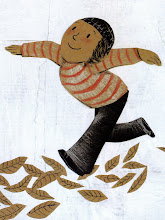 Tune into the Book Show on Radio National* next Monday morning to hear Leigh Hobbs and I interviewed for a story on gender imbalance in children's literature.
Tune into the Book Show on Radio National* next Monday morning to hear Leigh Hobbs and I interviewed for a story on gender imbalance in children's literature. This is an article that ran recently in the Guardian. To be honest, the story was an eye-opener. I have been reading a fair bit in blogs recently about gender imbalance in the adult publishing world (see Rachel Power's excellent post here) but hadn't considered it might be happening in children's publishing too.
As a children's author I aim to create strong female characters and sensitive boys to balance out the gender stereotypes that can often appear in kids' lit. Billie B Brown is probably the most obvious example, though looking over my body of work I notice that this combination appears regularly. As a mother of three sons, Billie is as much based on their childhoods as mine, though infuriatingly my 8 year old son explains that while he loves the stories he wouldn’t be caught dead reading them in public because there is a girl on the front cover (see Melvin Burgess’ comment in the Guardian article – a well-known truism among children’s authors). Admittedly, this is also partly due to the packaging and marketing of the Billie series, which is primarily directed towards girls.**
Returning to Burgess' comment, and in defense of the children's publishing industry, I think it is important to recognise that there has definitely been a recent push to try get boys hooked on books as, in general, girls are more inclined to read - and continue reading - whereas boys are often more reluctant. This might partly explain the disproportionate amount of males in contemporary children’s literature, even if it doesn't necessarily make the findings in the above article excusable. However, it's also important to remember that research shows that the most powerful way to get young boys reading – even more than creating books that “boys will like” or identify with – is for them to see their father reading. Or at least other males. Reading needs to be seen as something blokes do. Sadly, without this, boys will continue to assume that reading is a ‘girls’ activity and the children's publishing industry will have to continue to bend over backwards to try to attract boy readers any way they can.
*Or click here and I will add a link to the podcast after Monday.
**To counteract this I am currently in the process of creating a series of books from Billie’s best friend, Jack’s, point of view, which will still explore very similar themes, but from a boy's perspective. I will let you know my son's verdict when they come out.













Great post, Sally. And thanks for the links. Look fwd to hearing you and leigh 'live on the wireless'... jx
ReplyDeleteThanks Jen. Hopefully there will be something coherent in amongst all my ramblings!
ReplyDeleteInteresting subject. I wonder how much boys' unwillingness to read about female protagonists correlates with the actual content, or whether it has more to do with the book's cover. It would be interesting to see whether gender-neutral covers on books about female characters would attract more male readers.
ReplyDeleteKids' books certainly seem more gender-packaged these days, all in pink v grey; even the books that are not fairy princess horsey books feel very clearly gendered. When I walk into a bookshop, I feel like most books have been flagged as 'boy' or 'girl' even before I've looked at the title, let alone read the first page.
ReplyDeleteIt's a world away from Joan Aiken's wolves series - Dido Twite being the heroine and the covers all so gothic - even Gory did the covers for one reprint; or Margaret Mahy and her rollicking short stories for boys and girls in bright primary coloured covers.
Like Robyn, I find myself wondering if the Billie B Brown series, for example, would sell to boys if it had a different cover - do there need to be stories about her friend Jack for boys to read them, or could Billie be sold in a gender-neutral cover?